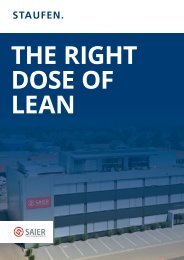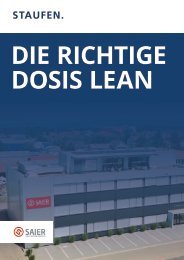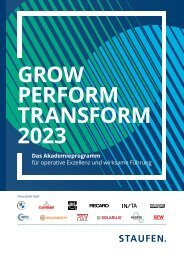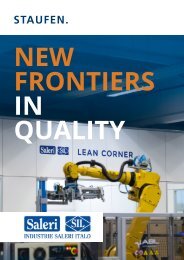whitepaper_staufen_predictive_restructuring_en_2019
Restructuring and turnaround projects have always been implemented only once a company has started to see negative earnings, or even experience a real fundamental financial crisis. In an increasingly dynamic world, however, this view is overly short-sighted. Volatile mar kets, aggressive competitors and investors, flexible working and digital change mean that changes are taking place with increasing rapidity. As a result, even established companies that are (still) seeing good earnings now face the challenge of securing their existing success at the same time as they are managing the transition to new business models and structures.
Restructuring and turnaround projects have always been implemented
only once a company has started to see negative earnings, or even experience a real fundamental financial crisis. In an increasingly dynamic world, however, this view is overly short-sighted. Volatile mar
kets, aggressive competitors and investors, flexible working and digital change mean that changes are taking place with increasing rapidity. As a result, even established companies that are (still) seeing good earnings now face the challenge of securing their existing success at the same time as they are managing the transition to new business models and structures.
Create successful ePaper yourself
Turn your PDF publications into a flip-book with our unique Google optimized e-Paper software.
RESTRUCTURING<br />
BEFORE THE EMERGENCY HAPPENS<br />
IS THE NEW KEY TO SUCCESS
CONTENT<br />
1<br />
Many crises are caused in-house 05<br />
Figure 1: Why is your company vulnerable? 06<br />
Figure 2: How vulnerable to crises is your company? 08<br />
2<br />
Classic <strong>restructuring</strong> – looking back 09<br />
3<br />
Predictive <strong>restructuring</strong> – looking ahead 11<br />
Figure 3: Assessing adaptability 12<br />
4<br />
The path to <strong>predictive</strong> <strong>restructuring</strong> 14<br />
5<br />
Conclusion: it needs a change of attitude 18<br />
Figure 4: Predictive Restructuring 19<br />
6<br />
How we recomm<strong>en</strong>d going about it 20<br />
Figure 5: Predictive Restructuring:<br />
six steps to lasting success as a business 21<br />
Whitepaper: Predictive Restructuring<br />
3
MANY CRISES<br />
ARE CAUSED<br />
IN-HOUSE<br />
Restructuring and turnaround projects have always be<strong>en</strong> implem<strong>en</strong>ted<br />
only once a company has started to see negative earnings, or ev<strong>en</strong><br />
experi<strong>en</strong>ce a real fundam<strong>en</strong>tal financial crisis. In an increasingly dynamic<br />
world, however, this view is overly short-sighted. Volatile markets,<br />
aggressive competitors and investors, flexible working and digital<br />
change mean that changes are taking place with increasing rapidity.<br />
As a result, ev<strong>en</strong> established companies that are (still) seeing good<br />
earnings now face the chall<strong>en</strong>ge of securing their existing success at<br />
the same time as they are managing the transition to new business<br />
models and structures.<br />
Simply waiting and seeing is oft<strong>en</strong> the beginning of the <strong>en</strong>d - which<br />
most company managers know from their own experi<strong>en</strong>ce: more than<br />
70 per c<strong>en</strong>t of top managers have already had to establish a new business<br />
model for a company or a division. This is one of the results of the<br />
Stauf<strong>en</strong> AG „Restructuring“ study, for which around 250 board members<br />
and managing directors were surveyed.<br />
Whitepaper: Predictive Restructuring<br />
5
WHY DO YOU THINK YOUR<br />
COMPANY IS VULNERABLE?<br />
1<br />
2<br />
3<br />
4<br />
5<br />
6<br />
7<br />
8<br />
9<br />
High dep<strong>en</strong>d<strong>en</strong>cy on<br />
particular regions / markets 46 %<br />
High dep<strong>en</strong>d<strong>en</strong>cy on<br />
particular customers 39 %<br />
High dep<strong>en</strong>d<strong>en</strong>cy on<br />
particular suppliers 33 %<br />
Lack of knowledge<br />
about future issues 26 %<br />
Poorly stocked<br />
innovation pipeline 25 %<br />
Outdated<br />
leadership methods 21 %<br />
Weak<br />
funding base 15 %<br />
Inflexible<br />
costing structures 14 %<br />
Other 1 %<br />
Figure 1<br />
6 Whitepaper: Predictive Restructuring
But what are the risks that most businesses face? The biggest risks<br />
cited by the company leaders surveyed in the Stauf<strong>en</strong> study were high<br />
dep<strong>en</strong>d<strong>en</strong>cies on particular regions/markets (46 per c<strong>en</strong>t), particular<br />
customers (39 per c<strong>en</strong>t) and particular suppliers (33 per c<strong>en</strong>t) (see figure<br />
1).<br />
Many companies, therefore, are dep<strong>en</strong>d<strong>en</strong>t on factors which, if<br />
the market changes or economic conditions are weak, may rapidly<br />
trigger crises. This is particularly obvious in, for instance,<br />
the automotive industries. The fact that they specialize, to some ext<strong>en</strong>t,<br />
very narrowly on an individual manufacturer’s model range<br />
makes suppliers extremely vulnerable.<br />
Corporate managem<strong>en</strong>t are g<strong>en</strong>erally very well aware of this type of<br />
sector-specific dep<strong>en</strong>d<strong>en</strong>cy and their opinion of their own situation is<br />
correspondingly critical: some one third (32 per c<strong>en</strong>t) consider their<br />
own company to be highly or ev<strong>en</strong> very highly vulnerable to crisis (see<br />
figure 2). Only 22 per c<strong>en</strong>t believe that a crisis would only affect them<br />
minimally or not at all. One of the main reasons for this perception is<br />
that numerous managers from medium-sized industry have already<br />
had experi<strong>en</strong>ce of financial problems, and have had to take appropriate<br />
countermeasures.<br />
The learning effect from this is that at least six out of t<strong>en</strong> businesses<br />
prepare themselves and run through crisis sc<strong>en</strong>arios and pot<strong>en</strong>tial<br />
counter-measures on a regular basis.<br />
Whitepaper: Predictive Restructuring<br />
7
HOW VULNERABLE TO CRISES DO YOU<br />
THINK YOUR COMPANY IS?<br />
6 %<br />
9 %<br />
16 %<br />
23 %<br />
46 %<br />
Vulnerability to crises (∑ 32%)<br />
Very high<br />
High<br />
Medium<br />
Not vulnerable to crises (∑ 22%)<br />
Minimal<br />
Not at all<br />
Figure 2<br />
8 Whitepaper: Predictive Restructuring
CLASSIC<br />
RESTRUCTURING<br />
Looking back<br />
Restructuring is traditionally se<strong>en</strong> as a company’s response to changes<br />
in underlying internal and external conditions which may lead to significant<br />
risks to their profitability and competitive position. It may ev<strong>en</strong><br />
be that the continued exist<strong>en</strong>ce of the company is under threat. In this<br />
case making small changes is no longer of any use; a compreh<strong>en</strong>sive<br />
reori<strong>en</strong>tation is required.<br />
This can only work if a company has devised a promising, sustainable<br />
concept. The first thing that needs to be done if this is to be achieved<br />
is to carry out a detailed analysis of the company’s status and pot<strong>en</strong>tial<br />
which also takes into account the views from both inside and out.<br />
Working process and organizational structures should be analyzed in<br />
this process, and transactions with suppliers, customers and distribution<br />
partners as well as in the markets need to be reviewed. It is important<br />
not just to look at any specific factors that have be<strong>en</strong> pinpointed<br />
as causes, but in particular to examine how complex the portfolio is<br />
and the way in which it interacts with the business processes, because<br />
the majority of crises, such as decreasing margins or market share,<br />
have a wide variety of causes which are all interdep<strong>en</strong>d<strong>en</strong>t on each<br />
other.<br />
There are three consecutive steps that make up a successful<br />
restructure.<br />
Whitepaper: Predictive Restructuring<br />
9
PHASE 1:<br />
Sound concept<br />
PHASE 2:<br />
Consist<strong>en</strong>t realization of pot<strong>en</strong>tial<br />
PHASE 3:<br />
Sustainable company developm<strong>en</strong>t<br />
The analysis and concept phase is short, with a strong focus on the<br />
value of the optimization lever, as well as on whether the pot<strong>en</strong>tial<br />
that has be<strong>en</strong> id<strong>en</strong>tified can feasibly be implem<strong>en</strong>ted.<br />
In the implem<strong>en</strong>tation phase, a core internal team comprising managers<br />
and service providers is defined. This team is tasked with continuing<br />
with the improvem<strong>en</strong>t process within the company, from the<br />
<strong>restructuring</strong> project through to systematic developm<strong>en</strong>t of the business.<br />
10 Whitepaper: Predictive Restructuring
PREDICTIVE<br />
RESTRUCTURING<br />
Looking ahead<br />
The classic model of <strong>restructuring</strong> in reaction to crises is no longer<br />
acceptable; the next industrial revolution is, after all, already in full<br />
swing. Around 90 per c<strong>en</strong>t of German industrial companies anticipate<br />
massive changes to their business over the next decade, and in almost<br />
half of companies uncertainty prevails over the upcoming upheavals.<br />
With good reason, as the “Change Readiness Index” (CRI) established<br />
by Stauf<strong>en</strong> reveals. The survey of 421 executives in German companies<br />
proves that at the pres<strong>en</strong>t time only a minority of businesses would be<br />
able to reinv<strong>en</strong>t themselves. This situation is aggravated by the fact<br />
that most managers overestimate the ability of their companies to<br />
make changes. Their own perception of the situation is considerably<br />
ahead of the reality (see figure 3).<br />
Whitepaper: Predictive Restructuring<br />
11
ASSESSMENT OF<br />
ADAPTABILITY<br />
on a scale from 0 = „not at all“ to 100 = „completely“<br />
STRUCTURES<br />
Perceived adaptability 72 %<br />
Actual adaptability 60 %<br />
Gap in perception ∆ 12<br />
PROCESSES<br />
Perceived adaptability 69 %<br />
Actual adaptability 60 %<br />
Gap in perception ∆ 9<br />
LEADERSHIP<br />
Perceived adaptability 69 %<br />
Actual adaptability 55 %<br />
Gap in perception ∆ 14<br />
EMPLOYEES AND QUALIFICATIONS<br />
Perceived adaptability 70 %<br />
Actual adaptability 58 %<br />
Gap in perception ∆ 12<br />
Figure 3: Change Readiness Index There is a significant gap in perception betwe<strong>en</strong> actual<br />
adaptability and perceived adaptability. The intuitions of the managers surveyed give a more<br />
positive picture than the figures derived from the detailed results of the study wh<strong>en</strong> looking at<br />
structures, processes, leadership and company culture, and employees/qualifications.<br />
12 Whitepaper: Predictive Restructuring
But ev<strong>en</strong> companies that consider their business models to be sustainable<br />
need to prepare themselves for greater pressure to be innovative.<br />
Digital transformation, in particular, is moving the goalposts in<br />
every industrial sector.<br />
Innovation cycles are getting shorter and shorter, competitors with<br />
the b<strong>en</strong>efit of a digital background are moving into markets previously<br />
believed to have be<strong>en</strong> safe, and ev<strong>en</strong> traditional customers are turning<br />
into competitors on an international scale. It requires a great deal of<br />
adaptability and power of innovation to be able to react successfully to<br />
these chall<strong>en</strong>ges. Leadership and corporate cultures that promote the<br />
ability and willingness to change at all levels are also vital.<br />
Whitepaper: Predictive Restructuring<br />
13
THE PATH<br />
TO PREDICTIVE<br />
RESTRUCTURING<br />
01. Lean Managem<strong>en</strong>t <strong>en</strong>hances<br />
adaptability<br />
The “Change Readiness Index” also evid<strong>en</strong>ces the positive influ<strong>en</strong>ce<br />
of Lean Managem<strong>en</strong>t on a company’s overall ability to adapt. There is<br />
already an above-average number of companies that have this ability,<br />
and whose value creation processes follow the Lean Managem<strong>en</strong>t<br />
principle. If Lean Managem<strong>en</strong>t is also applied in indirect areas, or indeed<br />
if the full Lean strategy is followed, these companies can become<br />
ev<strong>en</strong> more agile and flexible.<br />
Professor Daniel T Jones, founder of the Lean Enterprise Academy<br />
and co-author of “The Machine that Changed the World”, the standard<br />
work on the Lean philosophy, explains the Lean company’s good<br />
performance like this: “While traditional managem<strong>en</strong>t approaches use<br />
standardization to exercise control over the workforce, Lean Managem<strong>en</strong>t<br />
shows employees a way to achieve improvem<strong>en</strong>t through their<br />
own efforts. And wh<strong>en</strong> people drive the optimization of their own<br />
work themselves, they are capable of solving not just the problems of<br />
today; they also become increasingly better at facing the problems of<br />
tomorrow.”<br />
14 Whitepaper: Predictive Restructuring
02. Combining <strong>restructuring</strong> with<br />
approaches to leadership and change<br />
There will be a demand in the future for leaders who are not only<br />
capable of preparing people in the company for new chall<strong>en</strong>ges, but<br />
who are themselves <strong>en</strong>thusiastic about these changes. To achieve this,<br />
managem<strong>en</strong>t need to explain why it is ess<strong>en</strong>tial to change, and to establish<br />
confid<strong>en</strong>ce so that people’s fear of the uncertain future can be<br />
allayed and replaced with clear-cut objectives and steps for action. If<br />
the structure of a company is strongly hierarchical and managem<strong>en</strong>t<br />
like to keep a tight hold on the reins to make employees perform, this<br />
inhibits both initiative and the will to make changes.<br />
In organizations such as this, any change process is predestined to<br />
failure. The good news is that the overwhelming majority of German<br />
industrial companies are committed to a managem<strong>en</strong>t style that involves<br />
their employees. More than three quarters of companies claim<br />
that they have a flat hierarchy. Similarly, many of those surveyed believe<br />
that their own organization is capable of learning and is prepared<br />
for continuous improvem<strong>en</strong>t.<br />
Self-perception is, however, one thing and the reality within the organization<br />
is oft<strong>en</strong> something differ<strong>en</strong>t. On this point the Stauf<strong>en</strong> study<br />
pres<strong>en</strong>ts an interesting picture: on the one hand there is a commitm<strong>en</strong>t<br />
to flat hierarchies, while on the other hand there is a majority<br />
who g<strong>en</strong>erally impose changes from the top down. It is notable that<br />
important strategic decisions continue to be handled by the company’s<br />
managem<strong>en</strong>t. Nevertheless, the degree to which changes are<br />
ev<strong>en</strong> now still triggered in the boardroom alone is being noticed.<br />
Organizations that only allow personal responsibility or scope to be<br />
exercised wh<strong>en</strong> the matter is comparatively insignificant are <strong>en</strong>gaged<br />
in shadow-boxing, and this type of managem<strong>en</strong>t is not capable of unleashing<br />
the innovative power of the employees.<br />
Whitepaper: Predictive Restructuring<br />
15
03. The controller becomes the designer<br />
It is not just company and managem<strong>en</strong>t cultures that have to change,<br />
but also <strong>en</strong>tire job descriptions - including that of the controller. The<br />
traditional role of financial controller is mainly a top managem<strong>en</strong>t one,<br />
and the holder of this role has to take care of managem<strong>en</strong>t accounting<br />
and financial figures.<br />
All this involves looking almost exclusively at the past. This position as<br />
a “financial accountant” rarely means taking a proactive role. On the<br />
contrary, his very limited perspective may ev<strong>en</strong> induce s<strong>en</strong>ior managem<strong>en</strong>t<br />
to make judgem<strong>en</strong>ts that are less than ideal.<br />
The alternative is for the controller to adopt an integrating role. He becomes<br />
an interface, who adopts a holistic approach in order to create<br />
a mutual understanding within the company of the connections betwe<strong>en</strong><br />
operational processes and the top managem<strong>en</strong>t’s performance<br />
indicators. This <strong>en</strong>ables a meaningful correlation to be made betwe<strong>en</strong><br />
operational performance indicators such as productivity, quality and<br />
performance, and managem<strong>en</strong>t performance indicators. With these<br />
changes to the role, the controller can now start to play an ess<strong>en</strong>tial<br />
part in directing the value stream and in standard operational communication.<br />
The traditional function of the financial controller is now expanded<br />
to handle parts of the information, managem<strong>en</strong>t and planning<br />
processes in line with the Lean Managem<strong>en</strong>t concept.<br />
04. Integrated approach from<br />
analysis through to implem<strong>en</strong>tation<br />
In order to put <strong>predictive</strong> <strong>restructuring</strong> into practice successfully, it<br />
is ess<strong>en</strong>tial for a sustainable top-down method of working combined<br />
16 Whitepaper: Predictive Restructuring
with operational excell<strong>en</strong>ce to be in place (see figure 4). The bottom-up<br />
approach includes processes such as evaluation of the managem<strong>en</strong>t<br />
system, mapping of processes and interfaces, a study of individual<br />
jobs and systems, and a precise determination of pot<strong>en</strong>tial. With the<br />
top-down approach the structures of the company and the business<br />
become transpar<strong>en</strong>t and the product portfolio is structured, while the<br />
organizational and cost structures, as well as cost drivers and targets,<br />
are analyzed.<br />
All this put together creates a coher<strong>en</strong>t concept for positioning the<br />
right optimization levers, and also for determining whether the defined<br />
strategic targets are valid. The primary consideration for implem<strong>en</strong>tation<br />
is that the process of <strong>predictive</strong> <strong>restructuring</strong> must be implem<strong>en</strong>ted<br />
on a continuous basis and adapted to the changing market<br />
conditions, in order to <strong>en</strong>sure that the emerg<strong>en</strong>cy does not become a<br />
perman<strong>en</strong>t state.<br />
Whitepaper: Predictive Restructuring<br />
17
CONCLUSION:<br />
IT NEEDS<br />
A CHANGE OF<br />
ATTITUDE<br />
To achieve this, companies need to think of <strong>restructuring</strong> more broadly<br />
and always in combination with agile organization, digitization and<br />
leadership excell<strong>en</strong>ce. This is the only way to <strong>en</strong>sure that the transformation<br />
process remains sustainable (see figure 4). One crucial point is<br />
that the managem<strong>en</strong>t and corporate culture must promote the ability<br />
to change in all areas, because a learning organization can anticipate<br />
changes if an early warning system is in place. It is less susceptible to<br />
disruptions and can manage crises with a forward-looking plan. The<br />
primary chall<strong>en</strong>ge is to unite the complex variety of issues so as to<br />
produce an overall concept for transformation and to find suffici<strong>en</strong>t<br />
liquidity or viable financing to support this.<br />
WE CALL THIS<br />
PREDICTIVE<br />
RESTRUCTURING.<br />
18 Whitepaper: Predictive Restructuring
PREDICTIVE<br />
RESTRUCTURING<br />
Integrativer Ansatz<br />
Markets<br />
Top-downworking<br />
method<br />
Structures<br />
Networks<br />
Digitization<br />
New<br />
technologies<br />
Systems<br />
Excell<strong>en</strong>ce in<br />
value creation<br />
Growth in<br />
company value<br />
Developm<strong>en</strong>t of<br />
cultural values<br />
Resources<br />
Leadership /<br />
Change<br />
Cultures<br />
Processes<br />
Operational<br />
excell<strong>en</strong>ce<br />
Employees<br />
Abbildung 4<br />
Whitepaper: Predictive Restructuring<br />
19
HOW WE<br />
RECOMMEND<br />
GOING ABOUT IT<br />
The forecasts indicate another crisis. Nobody can yet tell how badly<br />
this is going to affect our economy. The only thing that is certain is that<br />
it is coming. The winners will be marked out from the losers by the<br />
ext<strong>en</strong>t to which a company is both crisis-proof and adaptable.<br />
Step 01: The analysis<br />
The most important thing is to be aware of where your value creation<br />
is most at risk and how all the individual factors are interdep<strong>en</strong>d<strong>en</strong>t.<br />
This knowledge will allow you to simulate future crisis sc<strong>en</strong>arios and<br />
you will know exactly what you need to focus your att<strong>en</strong>tion on in the<br />
future and which levers need to be tackled.<br />
It is also important to make a realistic assessm<strong>en</strong>t to prepare for an<br />
emerg<strong>en</strong>cy, if possible from the perspective of industry experts who<br />
have be<strong>en</strong> involved in many companies in the specific market conditions.<br />
Using Stauf<strong>en</strong> AG’s <strong>predictive</strong> <strong>restructuring</strong> approach, we analyze,<br />
simulate and derive specific instructions for action to <strong>en</strong>sure the<br />
future success of the individual company.<br />
20 Whitepaper: Predictive Restructuring
PREDICTIVE RESTRUCTURING: SIX STEPS<br />
TO LASTING SUCCESS AS A BUSINESS<br />
The key to adaptability in the future<br />
1. Analysis / quick check<br />
Id<strong>en</strong>tify the greatest pot<strong>en</strong>tial for risk<br />
to value creation<br />
2. Target Costing<br />
Define a clear target<br />
Define structures that are affordable<br />
3. “Growth without growing”<br />
Make use of operational pot<strong>en</strong>tial<br />
and boost with increased effici<strong>en</strong>cy<br />
4. Making fixed costs variable<br />
Minimum configuration<br />
of internal resources<br />
Adaptability<br />
Sustainability<br />
5. Agile Organization<br />
Rapid adaptation to changing<br />
customer requirem<strong>en</strong>ts<br />
6. Leadership Excell<strong>en</strong>ce and Change Managem<strong>en</strong>t<br />
Culture of continuous change and improvem<strong>en</strong>t<br />
Figure 5<br />
BECAUSE THE “BEST”<br />
CRISIS IS THE ONE THAT<br />
DOESN’T HAPPEN.<br />
Whitepaper: Predictive Restructuring<br />
21
STUDIES AND<br />
WHITE PAPERS<br />
All Stauf<strong>en</strong> AG studies can be found<br />
online at www.<strong>stauf<strong>en</strong></strong>.ag/studi<strong>en</strong><br />
22 Whitepaper: Predictive Restructuring
INSIDE EVERY<br />
COMPANY THERE IS AN<br />
EVEN BETTER ONE<br />
This has be<strong>en</strong> the conviction behind the Stauf<strong>en</strong> AG consulting and<br />
qualification services offered to companies and employees for more<br />
than 25 years.<br />
NUMBERS. DATA. FACTS.<br />
320<br />
staff members<br />
65<br />
Mio. € rev<strong>en</strong>ue<br />
> 70<br />
Best Practice Partners<br />
17<br />
languages 5.000<br />
seminar participants<br />
every year<br />
CONTACT PERSON<br />
Andreas Sticher<br />
Partner<br />
a.sticher@<strong>stauf<strong>en</strong></strong>.ag<br />
+49 7024 8056 0<br />
PRESS CONTACT<br />
Kathrin Negele<br />
Marketing Manager<br />
k.negele@<strong>stauf<strong>en</strong></strong>.ag<br />
+49 7024 8056 155<br />
PUBLISHER<br />
STAUFEN.AG<br />
Consulting.Academy.<br />
Investm<strong>en</strong>t<br />
Blum<strong>en</strong>straße 5<br />
D-73257 Köng<strong>en</strong><br />
+49 7024 8056 0<br />
www.<strong>stauf<strong>en</strong></strong>.ag<br />
kontakt@<strong>stauf<strong>en</strong></strong>.ag

















